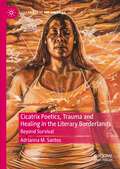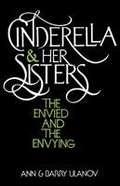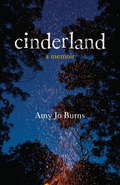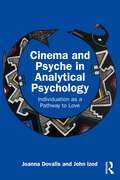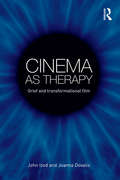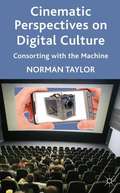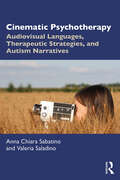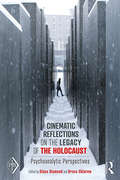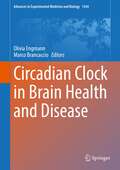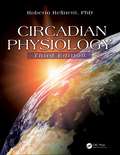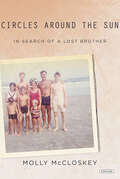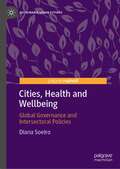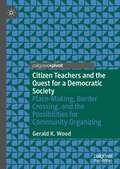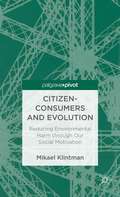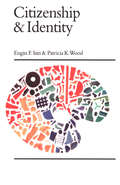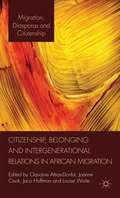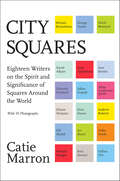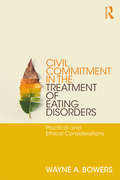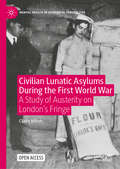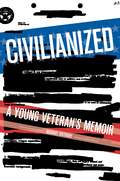- Table View
- List View
Cicatrix Poetics, Trauma and Healing in the Literary Borderlands: Beyond Survival (Literatures of the Americas)
by Adrianna M. SantosThis book explores how Chicana literature often represents gender violence while simultaneously presenting strategies of survival in response. Adrianna M. Santos aims to contribute to a broader conversation concerning the intersections between Chicana literature and decolonial trauma theory, one which questions the colonial matrix of power and the universality of Western knowledge. Santos argues that Chicana survival narratives arise out of colonial wounds and form scars that both mark and protect the violated body. Cicatrix Poetics, Trauma and Healing in the Literary Borderlands proposes a “cicatrix poetics” that makes bold gestures toward healing and narrative/storytelling as survival. The book contends that the cicatrix fashioned through artistic expression is a necessary component for Chicana communities—not just to survive, but to thrive. The books presents several case studies that examine transformative narrativity and by theorizing the texts as survival narratives, social protest works that bring attention to violence and erasure, the chapters explore how literature can be an effective catalyst for both social change and personal transformation, an orientation towards freedom, liberation through love.
Cinderella and Her Sisters: The Envied and the Envying
by Barry Ulanov Ann UlanovSeated in her nest of ashes, Cinderella embodies human misery. The essence of inner and outer nobility, she is the envy of her cruel stepmother and her ugly sisters. Using this familiar story, Ann and Barry Ulanov explore the psychological and theological aspects of envy and goodness. In their interpretation of the tale, they move back and forth between internal and external issues--from how feminine and masculine parts of persons fit or do not fit together to how individuals conduct their lives with those of the same and opposite sexes: how they conflict, compete, or join harmoniously.
Cinderland
by Amy Jo BurnsA riveting literary debut about the cost of keeping quietAmy Jo Burns grew up in Mercury, Pennsylvania, an industrial town humbled by the steel collapse of the 1980s. Instead of the construction booms and twelve-hour shifts her parents' generation had known, the Mercury Amy Jo knew was marred by empty houses, old strip mines, and vacant lots. It wasn't quite a ghost town--only because many people had no choice but to stay. The year Burns turned ten, this sleepy town suddenly woke up. Howard Lotte, its beloved piano teacher, was accused of sexually assaulting his female students. Among the countless girls questioned, only seven came forward. For telling the truth, the town ostracized these girls and accused them of trying to smear a good man's reputation. As for the remaining girls--well, they were smarter. They lied. Burns was one of them. But such a lie has its own consequences. Against a backdrop of fire and steel, shame and redemption, Burns tells of the boys she ran from and toward, the friends she abandoned, and the endless performances she gave to please a town that never trusted girls in the first place. This is the story of growing up in a town that both worshipped and sacrificed its youth--a town that believed being a good girl meant being a quiet one--and the long road Burns took toward forgiving her ten-year-old self. Cinderland is an elegy to that young girl's innocence, as well as a praise song to the curative powers of breaking a long silence. From the Hardcover edition.
Cinema and Psyche in Analytical Psychology: Individuation as a Pathway to Love
by John Izod Joanna DovalisPeering into the unconscious through cinema can give audiences an uncanny feeling about what lives in the beyond, something alien to consciousness. This book creates psychological interpretations of films that lend themselves to the depths, and investigates the personal and cultural appeal of cinema as a powerful art form.The selected films examined in this book circle around the process of individuation, focussing on different aspects of intellectual and emotional life from a Jungian lens. The first group of movies centres on three films, following plotlines that extend beyond the norms of routine drama, delving into alien territory. The second group presents three more films that, by comparison with the first, can be seen as typical dramas that focus on motifs of relationships. In the final chapter, the authors reflect on their own individuation journeys and life experiences that have informed the productive nature of their work together.This book will be of interest for therapists, students, and academics working in film studies, looking to engage in psychological studies in depth, as well as film goers who want to explore their relationship to the screen.
Cinema as Therapy: Grief and transformational film
by John Izod Joanna DovalisLoss is an inescapable reality of life, and individuals need to develop a capacity to grieve in order to mature and live life to the full. Yet most western movie audiences live in cultures that do not value this necessary process and filmgoers finding themselves deeply moved by a particular film are often left wondering why. In Cinema as Therapy, John Izod and Joanna Dovalis set out to fill a gap in work on the conjunction of grief, therapy and cinema. Looking at films including Million Dollar Baby, The Son’s Room, Birth and The Tree of Life, Cinema as Therapy offers an understanding of how deeply emotional life can be stirred at the movies. Izod and Dovalis note that cinema is a medium which engages people in a virtual dialogue with their own and their culture’s unconscious, more deeply than is commonly thought. By analysing the meaning of each film and the root cause of the particular losses featured, the authors demonstrate how our experiences in the movie theatre create an opportunity to prepare psychologically for the inevitable losses we must all eventually face. In recognising that the movie theatre shares symbolic features with both the church and the therapy room, the reader sees how it becomes a sacred space where people can encounter the archetypal and ease personal suffering through laughter or tears, without inhibition or fear, to reach a deeper understanding of themselves. Cinema as Therapy will be essential reading for therapists, students and academics working in film studies and looking to engage with psychological studies in depth as well as filmgoers who want to explore their relationship with the screen. The book includes a glossary of Jungian and Freudian terms which enhances the clarity of the text and the understanding of the reader.
Cinematic Perspectives on Digital Culture
by Norman TaylorExploring research into mobile phone use as props to subjective identity, Norman Taylor employs concepts from Michelle Foucault, Gilles Deleuze and actor network theory to discuss the affect of mechanisms of make-believe, from celebrity culture to avatar-obsessed game players, and digital culture.
Cinematic Psychotherapy: Audiovisual Languages, Therapeutic Strategies, and Autism Narratives
by Anna Chiara Sabatino Valeria SaladinoThis book investigates the therapeutic potential and efficacy of audiovisual languages, deepening the integration of film studies into neuropsychiatry and strategic psychotherapy. Within a theoretical framework including documentary studies, self-representational and amateur theories, and strategic psychotherapy, the book describes the key notions and methodologies for using audiovisual language in clinical therapy practice and autism spectrum disorder (ASD) interventions. The book, a review and update of the Italian Cinema terapeutico: Linguaggi audiovisivi e percorsi clinici, showcases the healing potential of creative participatory processes and self-representations that occur thanks to the relocation and amateurization of the contemporary cinematic experience. The authors propose an experimental therapeutic protocol, Video-Pharmakon, which aims to serve as a new integrated method for taking care of children and adolescents with ASD and their families. The protocol is illustrated in its methodologies and phases and supported through case studies. Scholars and practitioners of art therapy and narrative-based medical approaches, professionals working with clients with ASD, and any other student or professional interested in ASD, psychotherapy, and film studies will find this a valuable resource for current practice and future research interventions.
Cinematic Reflections on The Legacy of the Holocaust: Psychoanalytic Perspectives (Psychoanalytic Inquiry Book Series)
by Diana Diamond Bruce SklarewAn international group of psychoanalysts and film scholars address the enduring emotional legacy of the Holocaust in Cinematic Reflections on the Legacy of the Holocaust: Psychoanalytic Perspectives. Particular focus is given to how second and third generation survivors have explored and confronted the psychic reverberations of Holocaust trauma in cinema. This book focuses on how film is particularly suited to depict Holocaust experiences with vividness and immediacy. The similarity of moving images and sound to our dream experience allows access to unconscious processing. Film has the potential to reveal the vast panorama of Holocaust history as well as its intrapsychic reverberations. Yet despite the recent prominence of Holocaust films, documentaries, and TV series as well as scholarly books and memoirs, these works lack a psychoanalytic optic that elucidates themes such as the repetition compulsion, survival guilt, disturbances in identity, and disruption of mourning that are underlying leitmotifs. Cinematic Reflections on the Legacy of the Holocaust will be of great interest to psychoanalysts and therapists as well as to scholars in trauma, film, and Jewish studies. It is also of interest to those concerned with the prevention of genocide and mass atrocities and their long-term effects.
Circadian Clock in Brain Health and Disease (Advances in Experimental Medicine and Biology #1344)
by Olivia Engmann Marco BrancaccioIn this book, leading experts in the field review how circadian rhythms impact the brain. An essential function of mammalian life is the exploitation of the regularities provided by the 24-hour cycle of day and night. The development and evolution of circadian clock mechanisms have allowed us to optimally adapt our behavior and physiology to the external world. Not surprisingly, a growing body of evidence links the disruption of circadian rhythms by genetic, lifestyle and environmental factors to illnesses of the brain. In the first section of the book, readers will learn about the molecular and anatomic architecture of circadian function in mammals. The ways in which environmental disruptions and misalignments can influence such mechanisms and therefore impair brain function and health status are also addressed. In the second part, the focus shifts to those brain regions responsible for brain function and the body-wide regulation of circadian function. Amongst others, special attention is paid to the role of astrocytes and the brain’s reward and hyprocretin / orexin systems. The book concludes with an extensive discussion on the consequences of circadian rhythm dysfunction. Several chapters present the latest findings on Attention Deficit Hyperactivity Disorder, schizophrenia, autism spectrum disorder, drug abuse and mood disorders. Written by auhorities in the field, the book provides a state-of-the-art review of the latest findings on circadian clocks in the brain and highlights their potentially far-reaching impacts on our health and well-being. As such, it is essential reading for all neuroscientists and clinicians seeking to understand the intricate connections between circadian rhythms and brain health and illness.
Circadian Physiology
by Roberto Refinetti PhD.Circadian rhythms influence most of our life activities, notably getting up and going to sleep every day. This new edition of Circadian Physiology delves into the mechanisms surrounding how these rhythms work, the physiology and biology behind them, and the latest research on this cutting-edge field. The book also discusses a wide variety of practi
Circadian Rhythm Sleep-Wake Disorders: An Evidence-Based Guide for Clinicians and Investigators
by R. Robert AugerThis book resolves to bridge the communication gap between research and clinical practice for circadian rhythm sleep-wake disorders. Beginning with a scientific background on biological timekeeping, opening chapters describe the crucial nature of maintaining delicate temporal organization of physiological and molecular events within the body. Following this are discussions on circadian physiology and methods of circadian assessments. Subsequent chapters then relay comprehensive information regarding the International Classification of Sleep Disorders-defined circadian rhythm sleep-wake disorders (CRSWDs), specifically discussing etiology and epidemiology, but focusing on evidence-based treatment data. Concluding discussions provide guidance for the application of light therapy and discuss future roles for optimized lighting environments. Nuanced and market-demanded, Circadian Rhythm Sleep-Wake Disorders: An Evidence-Based Guide for Clinicians and Investigators is an invaluable resource for Sleep Medicine clinicians, circadian researchers, and other interested parties.
Circle Time for Emotional Literacy
by Sue RoffeyEmotional literacy has become an important issue in schools, and the ethos behind Circle Time is complementary to the thinking behind this. The Social, Emotional and Behavioural Skills curriculum (SEBS) is being established in schools, and it is recognised as contributing to a positive and successful school environment. Offering many new ideas and activities to try out in Circle Time, this book covers: - why your school needs Circle Time - how you go about starting Circle Time in your school - the underlying philosophy and basic rules - he role of the teacher as facilitator - how you make it work - what to do if language and attention issues are problematic - how to tackle common problems that can occur The activities look at promoting listening and attention skills, self-awareness and self-esteem, class cohesion and empathy, co-operation and friendship skills.
Circles Around the Sun: In Search of a Lost Brother
by Molly McCloskeyAn author attempts to uncover who her older brother was before schizophrenia took hold of him in this &“clear-eyed and heartbreaking&” memoir (Publishers Weekly). Molly McClosky&’s brother Mike was fourteen when she was born. So far apart in age, she barely knew him before schizophrenia took hold of him at the age of twenty-three. Within a few years, Mike&’s world began to fall apart. By the time Molly was old enough to begin to know him, Mike was heavily medicated and frequently delusional, living in hospitals or care homes or on the road. Years later, through reading an astonishing archive of letters preserved by her mother and grandmother, and interviewing old friends of Mike's, Molly began to piece together a picture of her brother's life, before and after the illness struck—the story of how a gifted and well-liked student and athlete was overtaken by a terrible illness that rendered him unrecognizable. Now she tells that story, which is also the story of her own demons and of the ways in which a seemingly perfect family can slowly fall apart, and in the end, regroup.
Circumplex Model: Systemic Assessment and Treatment of Families
by David Olson Candyce Smith Russell Douglas H SprenkleThis functional new volume introduces professionals to the Circumplex Model of Family Systems--one of the most respected and widely used approaches of its kind in family studies. Internationally known scholar/practitioners in the marriage and family therapy field demonstrate how the model can be used to assess couple and family dynamics and plan treatment interventions. They extend the use of the Circumplex Model for treating problem families using a range of clinical interventions at both the family level and broader social system level--including specific treatment populations--sex offenders, juvenile delinquents, truants, and multi-problem families. Designed as a multidisciplinary resource, this authoritative and accurate volume will assist social workers, psychologists, pastoral counselors, family therapists, and other mental health professionals who work with individuals in a family treatment context.
Citation Classics from the Journal of Business Ethics: Celebrating the First Thirty Years of Publication (Advances in Business Ethics Research #2)
by Alex C. Michalos Deborah C PoffThe Journal of Business Ethics was founded by Alex C. Michalos and Deborah C. Poff and published its first issue in March 1982. It is the most frequently cited business ethics journal in the world. The Journal has always offered a multi-disciplinary and international public forum for the discussion of issues concerning the interaction of successful business and moral virtue. Its authors and readers are primarily scholars and students in social sciences and philosophy , with special interests in the interaction of these disciplines with business or corporate responsibility. Since the field of business ethics grew simultaneously with the growth of the Journal, a collection of its most cited articles is tantamount to a collection of the articles that had the greatest influence in defining the field over its first 30 years of development. In this anniversary volume, an overview of citation classics from the Journal is presented, the 33 most frequently cited articles are reproduced and brief reflections on the impact of the Journal on the field are given from over 100 scholars who authored citation classics and/or distinguished papers, as well as those who served on the Editorial Board and/or are recognized as leaders in the field.
Cities, Health and Wellbeing: Global Governance and Intersectoral Policies (Sustainable Urban Futures)
by Diana SoeiroOn 25 September 2015, the United Nations General Assembly unanimously adopted Resolution 70/1, “Transforming our World: the 2030 Agenda for Sustainable Development”. Also known as 2030 Agenda, the document lays out 17 Sustainable Development Goals (SDGs) in the realm of ecology, society and economy. The current book focuses on three of these goals: SDG 16: Peace, Justice and Strong Institutions; SDG 3: Health and Wellbeing; SDG 11: Cities and Sustainable Communities. It is critical that interdisciplinary approaches go one step further and translate more effectively into intersectoral policies. This is particularly vital when it comes to urban planning and health. This book address the key question: In the context of a growing influence of European Union policies at a national level, can SDGs simultaneously contribute to harmonising sectoral policies and promoting intersectoral policies? Claiming a growing convergence between health and spatial planning, the main goal of the book is to formulate an answer to the following question: how can policymakers translate the SDGs effectively into public policies in order to improve cities, health and wellbeing?
Citizen Teachers and the Quest for a Democratic Society: Place-Making, Border Crossing, and the Possibilities for Community Organizing
by Gerald K. WoodThis book explores how citizen teachers can expand our capacities to generate more equitable and just spaces with families by working as community organizers. Paying particular attention to community organizing work in one elementary school, the book weaves stories and examples with theoretical understandings to support emerging citizen teachers in creating more democratic spaces. Each chapter provides key community organizing concepts and skills and offers lessons learned to identify what worked and what did not. By building solidarity with families, citizen teachers can effectively activate more powerful practices grounded in the lives of students, their families, and their communities while articulating a broader response to the conditions impacting educators.
Citizen-Consumers and Evolution: Reducing Environmental Harm through Our Social Motivation
by Mikael KlintmanThis book develops a groundbreaking, novel approach to examining ethical consumer behaviour from the perspective of evolutionary theory, illustrating the deeply rooted potentials and limits within society for reducing environmental harm.
Citizens and State Surveillance in Hungary and Romania: The Importance of Personality (Central and Eastern European Perspectives on International Relations)
by Paul TapThis book explores the impact of personality traits on people&’s acceptance of state surveillance used for national security purposes. So far, state surveillance has been analysed in relation to institutional factors, technological infrastructures or specific contexts. This book shifts the focus from institutional and systemic characteristics to individual traits. It shows the extent to which people&’s personality traits explain the acceptance of state surveillance. The book provides a comparative analysis of Hungary and Romania to outline the differences between two former communist countries. The key results illustrate that highly conscientious people, those who are active in their communities, and the well-informed persons accept state surveillance more.
Citizenship and Identity (Politics and Culture series)
by Engin F. Isin Patricia K. WoodThrough a detailed introductory discussion of the relation between the civil and the political, and between recognition and representation, this book provides a comprehensive vocabulary for understanding citizenship. It uses the work of T H Marshall to frame the critical interrogation of how ethnic, technological, ecological, cosmopolitan, sexual and cultural rights relate to citizenship. The authors show how the civil, political and social meanings of citizenship have been redefined by postmodernization and globalization.
Citizenship, Belonging and Intergenerational Relations in African Migration
by Claudine Attias-Donfut Joanne Cook Jaco Hoffman Louise WaiteThis book is an exciting additionto themigration studies literature, presentingresearch conducted in Britain, France and South Africa which explores the migration experiences of African families across two generations. Global processes of African migration areexamined through a comparative approach that employs an intergenerational lens to uncover the ways in which familial relations, citizenship and belonging are shaped post-migration. This comparative approach explores the commonalities of African migration as well as the differential impacts as a result of particular socio-cultural contexts and national migration regimes. The book enables readers to learn about the lived experiences of African migrants in areas such as citizenship, belonging, intergenerational transmission, work, education, social mobility and discrimination.
City Squares: Eighteen Writers on the Spirit and Significance of Squares Around the World
by Catie MarronIn this important collection, eighteen renowned writers, including David Remnick, Zadie Smith, Rebecca Skloot, Rory Stewart, and Adam Gopnik evoke the spirit and history of some of the world’s most recognized and significant city squares, accompanied by illustrations from equally distinguished photographers.Over half of the world’s citizens now live in cities, and this number is rapidly growing. At the heart of these municipalities is the square—the defining urban public space since the dawn of democracy in Ancient Greece. Each square stands for a larger theme in history: cultural, geopolitical, anthropological, or architectural, and each of the eighteen luminary writers has contributed his or her own innate talent, prodigious research, and local knowledge.Divided into three parts: Culture, Geopolitics, History, headlined by Michael Kimmelman, David Remnick, and George Packer, this significant anthology shows the city square in new light. Jehane Noujaim, award-winning filmmaker, takes the reader through her return to Tahrir Square during the 2011 protest; Rory Stewart, diplomat and author, chronicles a square in Kabul which has come and gone several times over five centuries; Ari Shavit describes the dramatic changes of central Tel Aviv’s Rabin Square; Rick Stengel, editor, author, and journalist, recounts the power of Mandela’s choice of the Grand Parade, Cape Town, a huge market square to speak to the world right after his release from twenty-seven years in prison; while award-winning journalist Gillian Tett explores the concept of the virtual square in the age of social media.This collection is an important lesson in history, a portrait of the world we live in today, as well as an exercise in thinking about the future. Evocative and compelling, City Squares will change the way you walk through a city.Contributors include:David Adjaye on Jemma e-Fnna, Marrakech • Anne Applebaum on Red Square, Moscow and Grand Market Square, Krakow • Chrystia Freeland on Euromaiden, Kiev • Adam Gopnik on Place des Vosges, Paris • Alma Guillermoprieto on Zocalo, Mexico City • Jehane Noujaim on Tahrir Square, Cairo • Evan Osnos on Tiananmen Square, Beijing • Andrew Roberts on Residential Squares, London • Elif Shafak on Taksim Square, Istanbul • Rebecca Skloot on American Town Squares • Ari Shavit on Rabin Square, Tel Aviv • Zadie Smith on the grand piazzas of Rome and Venice • Richard Stengel on Market Square, Grand Parade, Cape Town • Rory Stewart on Murad Khane, Kabul • Plus contributions by Gillian Tett, George Packer, David Remnick, and Michael Kimmelman; illustrations and photographs from renowned photographers, including: Thomas Struth, Philip Lorca di Corcia, and Josef Koudelka
Civil Commitment in the Treatment of Eating Disorders: Practical and Ethical Considerations
by Wayne BowersCivil Commitment in the Treatment of Eating Disorders presents a comprehensive view on the use of involuntary hospitalization in the treatment of patients with anorexia and other eating disorders. This volume synthesizes the existing empirical data and ethical perspectives surrounding this sometimes controversial approach to treatment in order to establish a balanced, compassionate understanding of current research and patient experiences. Particular attention is paid to the use and misuse of persuasion and coercion in civil commitment and to when these concepts are applicable. This accessible new volume prepares treatment providers to understand the role of civil commitment in their treatment practices and in patients’ recovery.
Civilian Lunatic Asylums During the First World War: A Study of Austerity on London's Fringe (Mental Health in Historical Perspective)
by Claire HiltonThis open access book explores the history of asylums and their civilian patients during the First World War, focusing on the effects of wartime austerity and deprivation on the provision of care. While a substantial body of literature on ‘shell shock’ exists, this study uncovers the mental wellbeing of civilians during the war. It provides the first comprehensive account of wartime asylums in London, challenging the commonly held view that changes in psychiatric care for civilians post-war were linked mainly to soldiers’ experiences and treatment. Drawing extensively on archival and published sources, this book examines the impact of medical, scientific, political, cultural and social change on civilian asylums. It compares four asylums in London, each distinct in terms of their priorities and the diversity of their patients. Revealing the histories of the 100,000 civilian patients who were institutionalised during the First World War, this book offers new insights into decision-making and prioritisation of healthcare in times of austerity, and the myriad factors which inform this.
Civilianized: A Young Veteran's Memoir
by Michael AnthonyAfter 12 months of military service in Iraq, Michael Anthony stepped off a plane, seemingly happy to be home--or at least back on US soil. He was 21 years old, a bit of a nerd, and carrying a pack of cigarettes that he thought would be his last. Two months later, Michael was stoned on Vicodin, drinking way too much, and picking a fight with a very large Hell's Angel. At his wit's end, he came to an agreement with himself: If things didn't improve in three months, he was going to kill himself. Civilianized is a memoir chronicling Michael's search for meaning in a suddenly destabilized world.
